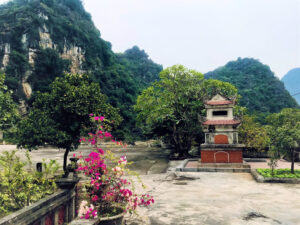Kim Ngân Pagoda is located in Chi Phong, on 2000m² of land that connects the East and West citadels of the ancient Hoa Lu capital. Legend has it that the pagoda was original constructed as the warehouse for King Le Dai Hanh’s bullion. Hence the name Golden Temple of Ngân. (Kim means “golden” in Vietnamese). To the more altruistic it is also known as the Đại Vân Pagoda as it is located at the foot of the Đại Vân Mountain.
After the assassination of Dinh Bo Linh and his oldest son, his six year old son was elevated as his successor. Such a young King was unacceptable to many and so the widowed Queen Duong Van Nga married her former husband’s military commander, General Le Hoan. The boy king promptly abdicated and Le Hoan became ruler in his place, taking the title of Emperor Lê Đại Hành and founding the Le Dynasty (981-1005). Such is love, war and politics.
Wealth
The Pagoda’s association with bullion was further elevated by the legend of how the Emperor Le Dai Hanh had two jars buried in nearby fields, one full of silver and the other gold. The legend says the reason was to incite a treasure hunt that would turn the then unused jungle into arable land. Either way, it was a smart move and the Kim Ngân Temple became associated with wealth and fortune. Even today, many pilgrims come here to pray for good luck in their business and commercial dealings.
Another belief says that worship during the advent of the Lunar New Year is always fulfilled. Visitors to Hoa Lua at such a propitious time will celebrate by attending the Pagoda to pray for good fortune and career advancement but especially money. Believe or not it, is a testament to the success of the legend that people continue to return year after year.
Foreign visitors to Hoa Lu during the Lunar New Year period could do worse than light an incense stick or two to the spirits of Kim Ngân Pagoda. Just remember to leave a donation – good luck works both ways.
Architecture
The pagoda itself is built on a flat plain and maintains the traditional Dinh (“T” shaped) architecture facing West-South with a stone wall surrounding the temple itself. The grounds are extensive and include the Tien Bai (5 compartments), Thuong Dien (2 compartments), an ancestral house (located to the west of the pagoda and including 5 front halls) and, of course, a harem space.
note: a harem here refers to a “woman’s house” , a place of refuge and sanctuary for female worshippers. There are no sexual implications, if fact the very opposite as only husbands and male relatives are traditionally allowed entrance.
The wooden pillars of the building are set on rock footings while the building itself is four stories high and roofed with slate tiles. Skilfully carved by ancient artists in the key Vietnamese-Buddhist themes of dragons, stylized flowers, and framed borders, these images enhance the beauty of the place and traditionally are thought to increase the spiritual and sacred significance of the building.
The main hall houses 5 rows of statues. In the first row, there are three statues representing the Past, Present, and Future worlds. The second row contains statues of the sacred images of Amitabha, Guan Yin Bodhisattva and the Đại Thế Chí Bodhisattva.
The third row is the new born Shakyamuni (Gautama Buddha) sitting on the Eternal throne while the fourth contains a representation of Saint Sangha (disciples of the Buddha) .The 5th and final row has a statue of the Tay Thiền – a representation of the Abbot of the temple.
Kim Ngan Pagoda Festival
Every year the pagoda organizes a festival on the first full moon in January. The festival celebrates both traditional and folk beliefs, with many praying for good luck, favourable weather and continued good crops. The highlight is a colourful and much loved procession of Dragon boats from the temple to the Bo De river wharf (Sao Khe). A truly memorable event if you are in the area at the right time.
In addition to the statue system, the Pagoda preserves a number of precious artifacts. Bronze bells, incense urns, ritual carvings and inscribed couplets, stylized “hammock” doors and the religious accoutrements all befitting its great age and the reverence it holds for the Vietnamese people.
Generally entrance to the temple complex is free as is the parking. However, if you visit during the festival, expect to pay around 10000-20000VND parking per vehicle. At such busy times, less spiritual people can gather and the fee includes a “guard” service. Even so, do not leave valuables in the vehicle.




